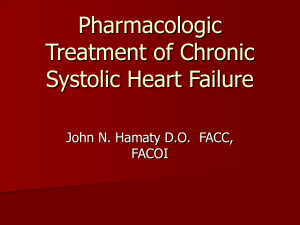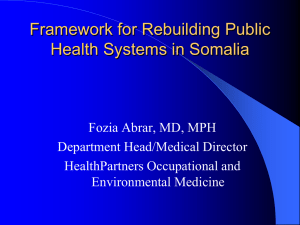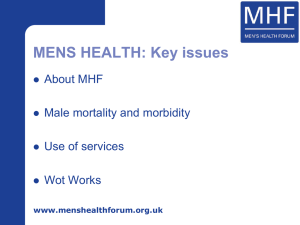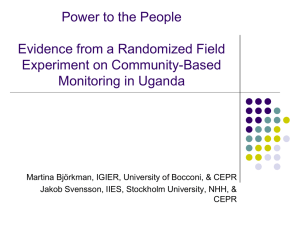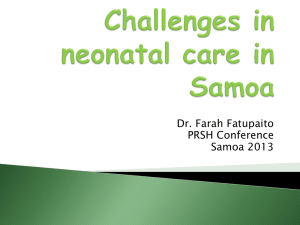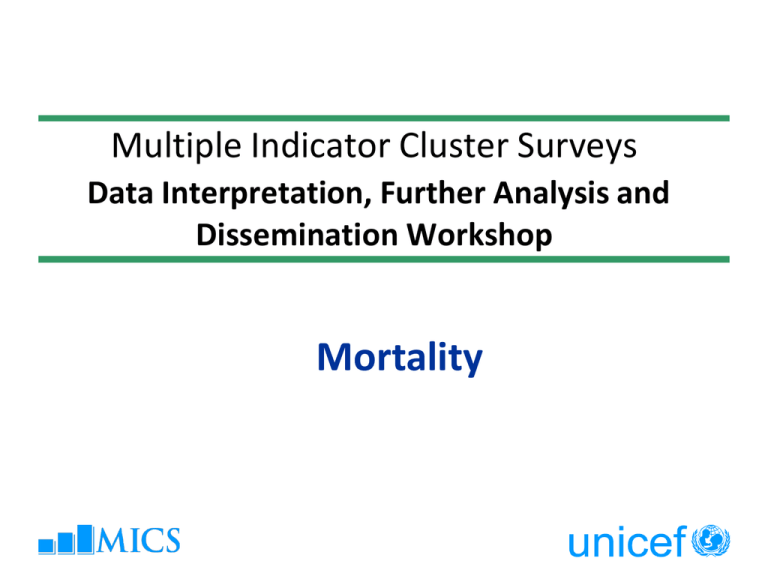
Multiple Indicator Cluster Surveys
Data Interpretation, Further Analysis and
Dissemination Workshop
Mortality
Background
Mortality during the first five years of life – broken
down by age segments and calculated as
probabilities…
but still called “rates”
Infant (first one year) & under-5 mortality rates (first
5 years) are the most commonly calculated
probabilities – the two MDG indicators
Periods for Under-5 Mortality Measurement
Measurement of child mortality
Conventional Data Sources
Vital registration
Population censuses
Surveillance systems, sample registration systems
Household surveys:
Birth histories: Direct estimates (DHS and MICS
surveys)
• Indirect estimates also possible
Summary birth histories: Indirect estimates (MICS
and other household surveys)
5
Direct estimation
Based on birth histories
Required data
Date of birth for all children born (month and year)
Survival status
Date or (more frequently) age at death for each child
who has died
Birth cohorts are retrospectively reconstructed and a
synthetic cohort life table approach used to estimate
indicators
6
7
Methods: Direct method
Rely heavily on the quality of information collected –
works best in populations where
dates and durations are well-known,
data is collected with well-trained interviewers
and good field supervision
Sources of errors:
Omission of births and deaths
Misreporting of age at death
(age heaping at 12 months is common)
Birth misplacement
8
Number of deaths
Heaping: Age at death in months
0
Niger 2006 DHS
3
6
9
12
15
18
21
24
Age at death (Months)
9
Age shifting: common issue in DHS
Niger: Births by year, DHS06
3000
Questions on under-5s for all
births after January 2001
2500
Numbers
2000
Living
Dead
Total
1500
1000
500
0
1996
1998
2000
2002
2004
2006
Year
10
Methods: Direct method
Check DQ tables to identify data quality issues in
birth histories
11
Lexis diagram
At time t’, cannot
calculate
probability
of birth cohorts
andtheexposure
of dying for cohort born
between t and t’ during
ages a and b
Possible to take
into account
exposure of
those born
between t-b
and t-a, as well
as truncated
exposure of
those born
between t’-b
and t’-a
12
Months
Deaths
0
1-2
3-5
6-11
12-23
24-35
36-47
48-59
Exposure 0
1-2
3-5
6-11
12-23
24-35
36-47
48-59
Probability 0
1-2
3-5
6-11
12-23
24-35
36-47
48-59
0-4
Mean
127.29
36.30
55.83
87.69
73.08
33.95
29.50
17.40
5061.22
4959.70
4952.79
4883.93
4779.04
4646.58
4429.36
4160.23
25.15
7.32
11.27
17.95
15.29
7.31
6.66
4.18
Periods of analysis of 5 years
5-9
10-14
15-19
Mean
Mean
Mean
120.99
92.62
83.44
48.67
39.74
36.56
83.91
76.83
68.97
121.44
123.54
72.57
93.78
88.43
62.28
37.37
43.95
45.12
34.44
29.03
24.06
11.93
11.01
11.19
4528.50
3553.57
2411.85
4353.69
3439.83
2300.73
4227.59
3366.39
2217.92
4059.39
3201.04
2080.97
3828.70
2874.25
1906.03
3549.07
2576.17
1691.19
3313.18
2369.72
1474.21
3130.20
2124.26
1335.26
26.72
26.07
34.60
11.18
11.55
15.89
19.85
22.82
31.10
29.92
38.59
34.87
24.49
30.77
32.67
10.53
17.06
26.68
10.40
12.25
16.32
3.81
5.18
8.38
20-24
Mean
54.59
28.62
51.59
54.55
50.65
25.18
11.13
7.04
1606.41
1540.65
1496.23
1412.65
1277.25
1117.07
986.87
856.83
33.98
18.58
34.48
38.61
39.66
22.54
11.28
8.22
SPSS
Table
13
Months
Deaths
0
1-2
3-5
6-11
12-23
24-35
36-47
48-59
Exposure 0
1-2
3-5
6-11
12-23
24-35
36-47
48-59
Probability 0
1-2
3-5
6-11
12-23
24-35
36-47
48-59
0-4
Mean
127.29
36.30
55.83
87.69
73.08
33.95
29.50
17.40
5061.22
4959.70
4952.79
4883.93
4779.04
4646.58
4429.36
4160.23
25.15
7.32
11.27
17.95
15.29
7.31
6.66
4.18
Periods of analysis of 5 years
5-9
10-14
15-19
20-24
unweighted numbers:
Mean
Mean
Mean Check
Mean
120.99
92.62
83.44
54.59
48.67
39.74
36.56
28.62
• Do not
show indicator if less
83.91
76.83
68.97
51.59
121.44
123.54
72.57than 250
54.55in any segment
93.78
88.43
62.28covered
50.65
37.37
43.95
45.12
25.18
• Parenthesize
if 250-499
34.44
29.03
24.06
11.13
11.93
11.01
11.19
7.04
4528.50
3553.57
2411.85
1606.41
4353.69
3439.83
2300.73
1540.65
4227.59
3366.39
2217.92
1496.23
4059.39
3201.04
2080.97
1412.65
3828.70
2874.25
1906.03
1277.25
3549.07
2576.17
1691.19
1117.07
3313.18
2369.72
1474.21
986.87
3130.20
2124.26
1335.26
856.83
26.72
26.07
34.60
33.98
11.18
11.55
15.89
18.58
19.85
22.82
31.10
34.48
29.92
38.59
34.87
38.61
24.49
30.77
32.67
39.66
10.53
17.06
26.68
22.54
10.40
12.25
16.32
11.28
3.81
5.18
8.38
8.22
Exposure at
beginning of
each interval
14
Months
Deaths
0
1-2
3-5
6-11
12-23
24-35
36-47
48-59
Exposure 0
1-2
3-5
6-11
12-23
24-35
36-47
48-59
Probability 0
1-2
3-5
6-11
12-23
24-35
36-47
48-59
0-4
Mean
127.29
36.30
55.83
87.69
73.08
33.95
29.50
17.40
5061.22
4959.70
4952.79
4883.93
4779.04
4646.58
4429.36
4160.23
25.15
7.32
11.27
17.95
15.29
7.31
6.66
4.18
Periods of analysis of 5 years
5-9
10-14
15-19
Mean
Mean
Mean
120.99
92.62
83.44
48.67
39.74
36.56
83.91
76.83
68.97
121.44
123.54
72.57
93.78
88.43
62.28
37.37
43.95
45.12
34.44
29.03
24.06
11.93
11.01
11.19
4528.50
3553.57
2411.85
4353.69
3439.83
2300.73
4227.59
3366.39
2217.92
4059.39
3201.04
2080.97
3828.70
2874.25
1906.03
3549.07
2576.17
1691.19
3313.18
2369.72
1474.21
3130.20
2124.26
1335.26
26.72
26.07
34.60
11.18
11.55
15.89
19.85
22.82
31.10
29.92
38.59
34.87
24.49
30.77
32.67
10.53
17.06
26.68
10.40
12.25
16.32
3.81
5.18
8.38
20-24
Mean
54.59
28.62
51.59
54.55
50.65
25.18
11.13
7.04
1606.41
1540.65
1496.23
1412.65
1277.25
1117.07
986.87
856.83
33.98
18.58
34.48
38.61
39.66
22.54
11.28
8.22
Neonatal
15
Months
Deaths
0
1-2
3-5
6-11
12-23
24-35
36-47
48-59
Exposure 0
1-2
3-5
6-11
12-23
24-35
36-47
48-59
Probability 0
1-2
3-5
6-11
12-23
24-35
36-47
48-59
0-4
Mean
127.29
36.30
55.83
87.69
73.08
33.95
29.50
17.40
5061.22
4959.70
4952.79
4883.93
4779.04
4646.58
4429.36
4160.23
25.15
7.32
11.27
17.95
15.29
7.31
6.66
4.18
Periods of analysis of 5 years
5-9
10-14
15-19
Mean
Mean
Mean
120.99
92.62
83.44
48.67
39.74
36.56
83.91
76.83
68.97
121.44
123.54
72.57
93.78
88.43
62.28
37.37
43.95
45.12
34.44
29.03
24.06
11.93
11.01
11.19
4528.50
3553.57
2411.85
4353.69
3439.83
2300.73
4227.59
3366.39
2217.92
4059.39
3201.04
2080.97
3828.70
2874.25
1906.03
3549.07
2576.17
1691.19
3313.18
2369.72
1474.21
3130.20
2124.26
1335.26
26.72
26.07
34.60
11.18
11.55
15.89
19.85
22.82
31.10
29.92
38.59
34.87
24.49
30.77
32.67
10.53
17.06
26.68
10.40
12.25
16.32
3.81
5.18
8.38
20-24
Mean
54.59
28.62
51.59
54.55
50.65
25.18
11.13
7.04
1606.41
1540.65
1496.23
1412.65
1277.25
1117.07
986.87
856.83
33.98
18.58
34.48
38.61
39.66
22.54
11.28
8.22
Post
Neonatal
16
Months
Deaths
0
1-2
3-5
6-11
12-23
24-35
36-47
48-59
Exposure 0
1-2
3-5
6-11
12-23
24-35
36-47
48-59
Probability 0
1-2
3-5
6-11
12-23
24-35
36-47
48-59
0-4
Mean
127.29
36.30
55.83
87.69
73.08
33.95
29.50
17.40
5061.22
4959.70
4952.79
4883.93
4779.04
4646.58
4429.36
4160.23
25.15
7.32
11.27
17.95
15.29
7.31
6.66
4.18
Periods of analysis of 5 years
5-9
10-14
15-19
Mean
Mean
Mean
120.99
92.62
83.44
48.67
39.74
36.56
83.91
76.83
68.97
121.44
123.54
72.57
93.78
88.43
62.28
37.37
43.95
45.12
34.44
29.03
24.06
11.93
11.01
11.19
4528.50
3553.57
2411.85
4353.69
3439.83
2300.73
4227.59
3366.39
2217.92
4059.39
3201.04
2080.97
3828.70
2874.25
1906.03
3549.07
2576.17
1691.19
3313.18
2369.72
1474.21
3130.20
2124.26
1335.26
26.72
26.07
34.60
11.18
11.55
15.89
19.85
22.82
31.10
29.92
38.59
34.87
24.49
30.77
32.67
10.53
17.06
26.68
10.40
12.25
16.32
3.81
5.18
8.38
20-24
Mean
54.59
28.62
51.59
54.55
50.65
25.18
11.13
7.04
1606.41
1540.65
1496.23
1412.65
1277.25
1117.07
986.87
856.83
33.98
18.58
34.48
38.61
39.66
22.54
11.28
8.22
Infant
17
Months
Deaths
0
1-2
3-5
6-11
12-23
24-35
36-47
48-59
Exposure 0
1-2
3-5
6-11
12-23
24-35
36-47
48-59
Probability 0
1-2
3-5
6-11
12-23
24-35
36-47
48-59
0-4
Mean
127.29
36.30
55.83
87.69
73.08
33.95
29.50
17.40
5061.22
4959.70
4952.79
4883.93
4779.04
4646.58
4429.36
4160.23
25.15
7.32
11.27
17.95
15.29
7.31
6.66
4.18
Periods of analysis of 5 years
5-9
10-14
15-19
Mean
Mean
Mean
120.99
92.62
83.44
48.67
39.74
36.56
83.91
76.83
68.97
121.44
123.54
72.57
93.78
88.43
62.28
37.37
43.95
45.12
34.44
29.03
24.06
11.93
11.01
11.19
4528.50
3553.57
2411.85
4353.69
3439.83
2300.73
4227.59
3366.39
2217.92
4059.39
3201.04
2080.97
3828.70
2874.25
1906.03
3549.07
2576.17
1691.19
3313.18
2369.72
1474.21
3130.20
2124.26
1335.26
26.72
26.07
34.60
11.18
11.55
15.89
19.85
22.82
31.10
29.92
38.59
34.87
24.49
30.77
32.67
10.53
17.06
26.68
10.40
12.25
16.32
3.81
5.18
8.38
20-24
Mean
54.59
28.62
51.59
54.55
50.65
25.18
11.13
7.04
1606.41
1540.65
1496.23
1412.65
1277.25
1117.07
986.87
856.83
33.98
18.58
34.48
38.61
39.66
22.54
11.28
8.22
Child
Months
Deaths
0
1-2
3-5
6-11
12-23
24-35
36-47
48-59
Exposure 0
1-2
3-5
6-11
12-23
24-35
36-47
48-59
Probability 0
1-2
3-5
6-11
12-23
24-35
36-47
48-59
0-4
Mean
127.29
36.30
55.83
87.69
73.08
33.95
29.50
17.40
5061.22
4959.70
4952.79
4883.93
4779.04
4646.58
4429.36
4160.23
25.15
7.32
11.27
17.95
15.29
7.31
6.66
4.18
Periods of analysis of 5 years
5-9
10-14
15-19
Mean
Mean
Mean
120.99
92.62
83.44
48.67
39.74
36.56
83.91
76.83
68.97
121.44
123.54
72.57
93.78
88.43
62.28
37.37
43.95
45.12
34.44
29.03
24.06
11.93
11.01
11.19
4528.50
3553.57
2411.85
4353.69
3439.83
2300.73
4227.59
3366.39
2217.92
4059.39
3201.04
2080.97
3828.70
2874.25
1906.03
3549.07
2576.17
1691.19
3313.18
2369.72
1474.21
3130.20
2124.26
1335.26
26.72
26.07
34.60
11.18
11.55
15.89
19.85
22.82
31.10
29.92
38.59
34.87
24.49
30.77
32.67
10.53
17.06
26.68
10.40
12.25
16.32
3.81
5.18
8.38
20-24
Mean
54.59
28.62
51.59
54.55
50.65
25.18
11.13
7.04
1606.41
1540.65
1496.23
1412.65
1277.25
1117.07
986.87
856.83
33.98
18.58
34.48
38.61
39.66
22.54
11.28
8.22
Under-5
19
Example: Calculation of infant mortality rate
Probability 0
1-2
3-5
6-11
12-23
24-35
36-47
48-59
25.15
7.32
11.27
17.95
15.29
7.31
6.66
4.18
26.72
11.18
19.85
29.92
24.49
10.53
10.40
3.81
26.07
11.55
22.82
38.59
30.77
17.06
12.25
5.18
34.60
15.89
31.10
34.87
32.67
26.68
16.32
8.38
33.98
18.58
34.48
38.61
39.66
22.54
11.28
8.22
Infant mortality is the probability of dying during the
first year of life
We need to calculate the probability of surviving
until the end of the first year of life, and subtract this
from 1.0
20
Example: Calculation of infant mortality rate
Probability 0
1-2
3-5
6-11
12-23
24-35
36-47
48-59
25.15
7.32
11.27
17.95
15.29
7.31
6.66
4.18
26.72
11.18
19.85
29.92
24.49
10.53
10.40
3.81
26.07
11.55
22.82
38.59
30.77
17.06
12.25
5.18
34.60
15.89
31.10
34.87
32.67
26.68
16.32
8.38
33.98
18.58
34.48
38.61
39.66
22.54
11.28
8.22
The probability of surviving until the end of the first
year of life is
(1 - 0.02515) * (1 – 0.00732) * (1 – 0.01127) * (1 – 0.01795)
= 0.939633
And the probability of dying is (1 – 0.939633) = 0.06037
21
Final (published) table
Periods of 0-4
analysis of 5-9
5 years
10-14
15-19
20-24
Neonatal
Post
Infant
Child
Under five
mortality
neonatal
mortality
mortality
mortality
25.15
35.22
60.37
33.06
91.43
26.72
58.20
84.92
48.44
129.25
26.07
69.52
95.59
63.85
153.33
34.60
76.99
111.58
81.61
184.09
33.98
85.98
119.96
79.52
189.94
We can use the mid-points of each period and show
these estimates on a graph to see trends
22
Plotting mortality rates
Under-5 mortality rate
Survey
date
200
180
160
140
120
100
80
60
40
20
0
1985
1990
1995
2000
2005
2010
2015
23
Standard tables
Table CM.2: Early childhood mortality rates by socioeconomic characteristics
Neonatal, post-neonatal, Infant, child and under-five mortality rates for the five year period preceding the survey, by
socioeconomic characteristics, Country, Year
Neonatal mortality
rate1
Post-neonatal
mortality rate2, a
Infant mortality
rate3
Child mortality
rate4
Under-five mortality
rate5
Total
Region
Region 1
Region 2
Region 3
Region 4
Region 5
Area
Urban
Rural
Mother's education
None
Primary
Secondary
Higher
24
Standard tables
Table CM.3: Early childhood mortality rates by demographic characteristics
Neonatal, post-neonatal, Infant, child and under-five mortality rates for the five year period preceding the survey, by
demographic characteristics, Country, Year
Neonatal mortality
rate1
Post-neonatal
mortality rate2, a
Infant mortality
rate3
Child mortality
rate4
Under-five mortality
rate5
Total
Sex of child
Male
Female
Mother's age at birth
Less than 20
20-34
35-49
Birth order
1
2-3
4-6
7+
Previous birth intervalb
< 2 years
2 years
3 years
4+ years
25
Indirect estimation: Age version
Required data:
Age of women
The total number of children ever born by women
The total number of children who have died
(or, the number who are still alive)
Requires the same information as the direct method,
with the exception of dates of birth and ages at
death – only aggregate numbers
26
Indirect estimation: Age version
Distributes children ever born to women
retrospectively over time using mathematical models
Assumptions:
Little or no change in fertility levels & age patterns
No change or a linear decline in mortality
A pattern of mortality by age that conforms to
known model life table “families” which basically
derived from European experience
27
Indirect estimation: Age version
Age
total1
15-19
meanceb
totceb
meansurv
totsurv
propdead
women
Mean number of Total number of
Total number of
Number of
children ever
children ever
Mean number
children
women age 15born
born
children surving
surviving
Proportion dead
49 years
.082
742
.077
694
.064
9071
20-24
.521
4601
.488
4312
.063
8831
25-29
.996
9316
.934
8732
.063
9354
30-34
1.364
10139
1.257
9340
.079
7432
35-39
1.615
11225
1.463
10171
.094
6950
40-44
1.906
10858
1.689
9624
.114
5697
45-49
2.135
9513
1.828
8145
.144
4456
Total
1.089
56394
.985
51017
.095
51791
28
Distribution of children born to women in
each age group by the number of years
since birth
29
Indirect estimation: Age version
Converts proportion dead of children ever born D(i)
reported by women in age groups 15-19, 20-24, etc.
into estimates of probability of dying before
attaining certain exact childhood ages, q(x):
q(x) = K(i)*D(i)
where the multiplier K(i) is meant to adjust for non
mortality factors determining the value of D(i)
30
Indirect estimation: Age version
The age pattern of child mortality
(Select the right model life table)
Coale-Demeny patterns by region:
East, North, South, and West
United Nations patterns by region:
Latin America, Chilean, South Asian, Far Eastern,
and General
31
Select the right model life table
32
Indirect estimation: Age version
Age
total1
15-19
meanceb
totceb
meansurv
totsurv
propdead
women
Mean number of Total number of
Total number of
Number of
children ever
children ever
Mean number
children
women age 15born
born
children surving
surviving
Proportion dead
49 years
.082
742
.077
694
.064
9071
20-24
.521
4601
.488
4312
.063
8831
25-29
.996
9316
.934
8732
.063
9354
30-34
1.364
10139
1.257
9340
.079
7432
35-39
1.615
11225
1.463
10171
.094
6950
40-44
1.906
10858
1.689
9624
.114
5697
45-49
2.135
9513
1.828
8145
.144
4456
Total
1.089
56394
.985
51017
.095
51791
Check unweighted denominators for
each age group - numbers of children
ever born
33
Indirect estimation: Age version
15-19
20-24
25-29
30-34
35-39
40-44
45-49
Mean
children
ever born
.150
.985
1.923
2.643
3.208
3.709
4.045
Proportion
children
dead of
born
.046
.057
.057
.070
.089
.107
.137
Age i
1
2
3
5
10
15
20
Q(i)
t(i)
Q(i)
North
North South
.050
.9
.049
.056
2.2
.059
.053
4.2
.056
.068
6.6
.070
.091
9.3
.090
.108
12.1
.107
.136
15.1
.135
t(i)
South
.9
2.3
4.4
6.9
9.8
12.8
16.0
Q(i)
East
.051
.059
.056
.070
.090
.107
.135
t(i)
East
.9
2.3
4.5
7.1
10.0
13.1
16.4
Q(i)
t(i)
West
West
.051
.9
.059
2.3
.056
4.4
.070
7.0
.089
9.8
.106
12.7
.135
15.6
34
Infant
Reference Mortality Reference
date North Rate North date South
15-19
20-24
25-29
30-34
35-39
40-44
45-49
15-19
20-24
25-29
30-34
35-39
40-44
45-49
2012.2
2010.9
2008.9
2006.5
2003.8
2001.0
1998.1
Reference
date North
2012.2
2010.9
2008.9
2006.5
2003.8
2001.0
1998.1
.050
.048
.042
.046
.053
.057
.065
2012.2
2010.9
2008.8
2006.2
2003.3
2000.3
1997.1
Under-five
Mortality Reference
Rate North date South
.075
2012.2
.071
2010.9
.060
2008.8
.068
2006.2
.079
2003.3
.087
2000.3
.100
1997.1
Infant
Mortality
Rate
South
.049
.053
.049
.057
.068
.075
.086
Infant
Infant
Reference Mortality Reference Mortality
date East Rate East date West Rate West
2012.2
2010.8
2008.6
2006.0
2003.1
2000.0
1996.8
.051
.054
.050
.059
.069
.076
.089
2012.2
2010.8
2008.7
2006.2
2003.4
2000.5
1997.5
.051
.051
.046
.053
.061
.067
.076
Under-five
Mortality
Under-five
Under-five
Rate
Reference Mortality Reference Mortality
South
date East Rate East date West Rate West
.059
2012.2
.061
2012.2
.067
.064
2010.8
.064
2010.8
.067
.059
2008.6
.059
2008.7
.060
.070
2006.0
.070
2006.2
.070
.087
2003.1
.084
2003.4
.082
.099
2000.0
.095
2000.5
.091
.118
1996.8
.113
1997.5
.107
35
Standard tables
Table CM.2: Infant and under-5 mortality rates by age groups of
women
Indirect estimates of infant and under-5 mortality rates by age of w omen, and
reference dates for estimates, [Model used] model, Country, Year
Reference date
Infant mortality rate
Under-5 mortality rate
Age
15-19
20-24
25-29
30-34
35-39
40-44
45-49
36
Plotting mortality rates
Under-5 mortality rate
120
Survey
date
100
80
60
40
20
0
1996
1998
2000
As the “final” or
“most recent”
estimate, we use
an average of
estimates2004
based on
2002
2006
women age 25-29
and 30-34
2008
2010
These estimates
are not used as
they are based on
predominantly first
births
2012 and births
2014 to
adolescents
37
“Final” estimates
Table CM.2: Child mortality
Infant and under-five mortality rates, MICS Survey, 2010
Sex
Area
Mother's education
Wealth index quintiles
Total
Male
Infant Mortality
Under-five
Rate [1]
Mortality Rate [2]
54
79
Female
40
58
Urban
31
41
Rural
54
81
None
51
77
Primary
42
61
Secondary+
24
31
Poorest
68
106
Second
58
88
Middle
50
74
Fourth
39
55
Richest
17
22
47
69
38
Indirect estimation: Time since first birth version
Required data:
Date of first birth for each woman (or number of
years since first birth)
The total number of children ever born by women
in each time since first birth group
The total number of children who have died
among these children (or, the number who are
still alive)
“Age groups” are replaced by “Time since first birth
groups”
39
Indirect estimation: Time since first birth version
Mean number of
children ever
born
2.542
Total
90,360
Mean number
children
csurving
2.345
1.225
9,207
1.167
8,767
.048
7515
Time since 5-9
first birth 10-14
2.031
16,522
1.919
15,611
.055
8136
2.800
22,539
2.600
20,932
.071
8050
15-19
3.338
21,986
3.050
20,094
.086
6587
20-24
3.822
20,107
3.411
17,946
.107
5261
Total
0-4
Proportion Number of
Total
dead
women
83,349
.078
35549
40
Indirect estimation: Time since first birth version
Time
Mean
since first children
birth
ever born
Proportion
children
dead of
born
Q(i)
North
Age i
t(i)
North
Q(i)
South
t(i)
South
Q(i)
East
t(i) East
Q(i)
West
t(i) West
0-4
1.225
.048
2
.054
2.1
.052
2.0
.054
2.0
.054
2.1
5-9
10-14
15-19
20-24
2.031
2.800
3.338
3.822
.055
.071
.086
.107
5
5
5
15
.058
.071
.082
.108
4.9
7.6
10.3
13.3
.058
.068
.077
.110
4.6
7.2
9.8
12.6
.059
.072
.083
.109
4.8
7.5
10.2
13.2
.058
.070
.080
.108
4.8
7.5
10.1
12.9
Generates estimates that are closer to the survey date
“Selection bias” less pronounced
Uses data better (5 groups as opposed to 7)
Distribution of births by time since first birth occur within
narrower time intervals
41
Indirect estimation: Time since first birth version
Infant
0-4
2011.0
.046
.067
2011.1
.050
.058
2011.1
.047
.061
2011.1
Under-five
Mortality
Rate
South
.047
.057
5-9
10-14
15-19
20-24
2008.2
2005.5
2002.8
1999.9
.040
.048
.054
.057
.058
.071
.082
.087
2008.3
2005.6
2002.9
1999.9
.050
.060
.068
.078
.059
.072
.083
.097
2008.3
2005.7
2003.0
2000.3
.045
.053
.059
.068
.058
.070
.080
.093
2008.5
2005.9
2003.3
2000.6
.049
.056
.061
.077
Time
Infant
Under-five
Infant
Under-five
Infant
Under-five
Mortality
since first Reference Mortality Mortality Reference Mortality Mortality Reference Mortality Mortality Reference
Rate
birth
date North Rate North Rate North date East Rate East Rate East date West Rate West Rate West date South
South
.058
.068
.077
.101
42
Plotting mortality rates
Under-5 mortality rate
100
90
Survey
date
80
70
60
50
40
30
20
10
0
1998
2000
2002
Used as the “final”,
“most recent”
estimate – however,
analysis ongoing on
2004 whether
2006 this2008
number2010
is also subject to
selection biases
2012
2014
43
“Final” estimates
Infant Mortality
Under-five
Rate [1]
Mortality Rate [2]
47
61
Total
Sex
Area
Mother's education
Wealth index quintiles
Male
55
71
Female
38
50
Urban
40
50
Rural
49
64
None
70
97
Primary incomplete
76
107
Primary complete
52
69
Secondary incomplete
38
48
Secondary complete or
higher
Poorest
27
32
54
72
Second
60
81
Middle
53
70
Fourth
52
69
Richest
19
21
44
MICS5 and mortality estimation
Majority of surveys now including birth histories,
which allows direct estimation
From these surveys, direct estimates are generated
and presented, but indirect estimates should also be
produced (for checking data quality)
When direct estimates are available, does not make
sense to publish indirect estimates as well
45
MICS5 and mortality estimation
If birth histories are not included, generate both age
and time since first birth (TSFB) versions
Interagency group recommends the use of the TSFB
version – a very recent development
Produce and compare both versions, decide which
one will be used based on objective technical
evaluation (sample sizes, patterns, out of range
values, fluctuations)
46
MICS5 and mortality estimation
Mortality estimates (both direct and indirect) are
subject to relatively wide confidence intervals
Need to calculate sampling errors
Recently developed program (CMRJack) used to
calculate sampling errors – will be adopted to MICS
programming
47
Data quality issues in indirect estimation
Main errors in data on children ever born and children
dead/surviving
Omission of deaths
Misreporting of women’s age or TSFB
Other drawbacks
Many assumptions
Use of models and applicability
Can only provide “rough” estimates (level and timing) –
not sensitive enough to showing changes over short
periods of time
48
For further analysis
Compare estimates from different sources
Analyze mortality by coverage indicators
Check age patterns of mortality (from direct
method), compare with model patterns
Multivariate analyses
49
The IGME Work
50
Members of the IGME
UN Inter-agency Group for Child Mortality Estimation
(IGME) was formed in 2004, led by UNICEF, WHO, and
includes members of UN Population Division and The
World Bank
Technical Advisory Group (TAG) of the IGME
Independent
Composed of leading experts in demography and
biostatistics
Provide technical guidance on estimation methods,
technical issues and strategies for data analysis and
data quality assessment
51
Objectives of the IGME
Objectives of the IGME
Harmonize estimates within the UN system
Improve methods for child mortality estimation
Produce consistent estimates of child mortality
worldwide for reporting on progress towards MDG 4
Enhance the capacity of countries to produce timely
estimates of child mortality: regional workshops and
country visits
52
The IGME method to estimate child mortality
Update estimates annually
Compile all nationally representative data for each country
Check data quality
Fit a regression line to all data points that meet data
quality standards established by the IGME and extrapolate
to a common reference year
Additional adjustment applied to countries with high
HIV/AIDS prevalence
The IGME Estimates are based on national data from surveys,
census, vital registrations, etc, but may differ from these data
53
Why is it necessary to produce interagency
child mortality estimates
No single, high quality source in most countries
Multiple data sources often inconsistent
Project estimates
Important to estimate since 1990
Consistent methodology
54
Example: Data rich and consistency countries
Mali
The available data sources
cluster over a narrow
band and show
considerable consistency
The estimate line is fitted
to all the data
55
Example: Data rich countries with wide variations in
mortality level from different sources
Nigeria
Has one of the widest
spreads of source
data, with a range
from 120 to 240
deaths per 1,000 live
birth
In driving the estimate
line, all sources with
dotted lines are rated
of lower quality and
are not used.
56
Discrepancies between national and
interagency estimates
National estimates: often use data directly from censuses,
surveys, or vital registration systems
IGME estimates: use national data from censuses, surveys, or
vital registration systems as underlying data to generate
estimates by fitting a trend line to these data
For countries with consistent data, national estimates and
interagency estimates are similar.
For countries with inconsistent or messy data, differences
might be large
57
CMEInfo
The IGME’s Child Mortality Database:
www.childmortality.org
58
Thank You
59


